Relationship between Specific Field-Based Physical Fitness Test Results and Selected Health Biomarkers in College-Aged Males: A Cross-Sectional Study
Abstract
:1. Introduction
2. Materials and Methods
2.1. Type of Study
2.2. Participants
2.3. Assessments
2.3.1. Anthropometric and Health Variables
2.3.2. Fitness Tests
2.4. Statistical Analysis
3. Results
4. Discussion
5. Conclusions
6. Practical Applications
Funding
Institutional Review Board Statement
Informed Consent Statement
Data Availability Statement
Conflicts of Interest
References
- World Health Organization. The Global Health Observatory. Available online: https://www.who.int/data/gho/data/major-themes/health-and-well-being#:~:text=The%20WHO%20constitution%20states%3A%20%22Health,of%20mental%20disorders%20or%20disabilities (accessed on 7 October 2022).
- Brooks, J.; Ahmad, I.; Easton, G. Promoting physical activity: The general practice agenda. Br. J. Gen. Pract. J. R. Coll. Gen. Pract. 2016, 66, 454–455. [Google Scholar] [CrossRef] [PubMed] [Green Version]
- Polet, J.; Hassandra, M.; Lintunen, T.; Laukkanen, A.; Hankonen, N.; Hirvensalo, M.; Tammelin, T.; Hagger, M.S. Using physical education to promote out-of school physical activity in lower secondary school students—A randomized controlled trial protocol. BMC Public Health 2019, 19, 157. [Google Scholar] [CrossRef] [PubMed] [Green Version]
- Sylvia, L.G.; Bernstein, E.E.; Hubbard, J.L.; Keating, L.; Anderson, E.J. Practical guide to measuring physical activity. J. Acad. Nutr. Diet. 2014, 114, 199–208. [Google Scholar] [CrossRef] [Green Version]
- Macfarlane, D.J.; Lee, C.C.; Ho, E.Y.; Chan, K.L.; Chan, D. Convergent validity of six methods to assess physical activity in daily life. J. Appl. Physiol. 2006, 101, 1328–1334. [Google Scholar] [CrossRef] [PubMed] [Green Version]
- Reilly, J.J.; Penpraze, V.; Hislop, J.; Davies, G.; Grant, S.; Paton, J.Y. Objective measurement of physical activity and sedentary behaviour: Review with new data. Arch. Dis. Child. 2008, 93, 614–619. [Google Scholar] [CrossRef]
- Grant, C.C.; Janse van Rensburg, D.; Pepper, M.; du Toit, P.S.; Wood, P.; Ker, J.; Krüger, P.; Grobbelaar, C.J.; Nolte, K.; Fletcher, F.; et al. The correlation between the health-related fitness of healthy participants measured at home as opposed to fitness measured by sport scientists in a laboratory. S. Afr. Fam. Pract. 2014, 56, 235–239. [Google Scholar] [CrossRef] [Green Version]
- Santos, R.; Mota, J. The ALPHA health-related physical fitness test battery for children and adolescents. Nutr. Hosp. 2011, 26, 1199–1200. [Google Scholar]
- Raghuveer, G.; Hartz, J.; Lubans, D.R.; Takken, T.; Wiltz, J.L.; Mietus-Snyder, M.; Perak, A.M.; Baker-Smith, C.; Pietris, N.; Edwards, N.M.; et al. Cardiorespiratory Fitness in Youth: An Important Marker of Health: A Scientific Statement from the American Heart Association. Circulation 2020, 142, e101–e118. [Google Scholar] [CrossRef]
- Ruiz, J.R.; España Romero, V.; Castro Piñero, J.; Artero, E.G.; Ortega, F.B.; Cuenca García, M.; Jiménez Pavón, D.; Chillón, P.; Girela Rejón, M.J.; Mora, J.; et al. ALPHA-fitness test battery: Health-related field-based fitness tests assessment in children and adolescents. Nutr. Hosp. 2011, 26, 1210–1214. [Google Scholar]
- National Curriculum in England: PE Programmes of Study. Available online: https://www.gov.uk/government/publications/national-curriculum-in-england-physical-education-programmes-of-study (accessed on 12 August 2022).
- Real Decreto 1105/2014, de 26 de Diciembre, por el que se Establece el Currículo Básico de la Educación Secundaria Obligatoria y del Bachillerato [Royal Decree 1105/2014, of December 26, Establishing the Basic Curriculum for Compulsory Secondary Education and the Baccalaureate]. Available online: https://www.boe.es/buscar/act.php?id=BOE-A-2015-37 (accessed on 12 August 2022).
- Etches, V.; Frank, J.; Di Ruggiero, E.; Manuel, D. Measuring population health: A review of indicators. Annu. Rev. Public Health 2006, 27, 29–55. [Google Scholar] [CrossRef] [Green Version]
- Zeiher, J.; Ombrellaro, K.J.; Perumal, N.; Keil, T.; Mensink, G.; Finger, J.D. Correlates and Determinants of Cardiorespiratory Fitness in Adults: A Systematic Review. Sport. Med.-Open 2019, 5, 39. [Google Scholar] [CrossRef] [Green Version]
- Ortega, F.B.; Ruiz, J.R.; Castillo, M.J.; Sjöström, M. Physical fitness in childhood and adolescence: A powerful marker of health. Int. J. Obes. 2008, 32, 1–11. [Google Scholar] [CrossRef]
- Ruiz, J.R.; Castro-Piñero, J.; Artero, E.G.; Ortega, F.B.; Sjöström, M.; Suni, J.; Castillo, M.J. Predictive validity of health-related fitness in youth: A systematic review. Br. J. Sport. Med. 2009, 43, 909–923. [Google Scholar] [CrossRef]
- Suni, J.H.; Oja, P.; Miilunpalo, S.I.; Pasanen, M.E.; Vuori, I.M.; Bös, K. Health-related fitness test battery for adults: Associations with perceived health, mobility, and back function and symptoms. Arch. Phys. Med. Rehabil. 1998, 79, 559–569. [Google Scholar] [CrossRef]
- Martínez-Vizcaíno, V.; Sánchez-López, M. Relación entre actividad física y condición física en niños y adolescentes [Relationship between physical activity and physical fitness in children and adolescents]. Rev. Esp. Cardiol. 2008, 61, 108–111. [Google Scholar] [CrossRef]
- Bryce-Moncloa, A.; Alegría-Valdivia, E.; San Martin-San Martin, M.G. Cardiovascular risk and obesity. An. Fac. Med. 2017, 78, 202–206. [Google Scholar] [CrossRef] [Green Version]
- Kothari, C.R. Research Methodology: Methods and Techniques; New Age International: New Delhi, India, 2009. [Google Scholar]
- González-Gallego, J.; Collado, P.S.; Mataix, J. Nutrición en el deporte. Ayudas Ergogénicas y Dopaje. [Nutrition in sport. Ergogenic aids and doping]; Díaz de Santos: Madrid, Spain, 2006. [Google Scholar]
- Eguchi, K.; Kuruvilla, S.; Ogedegbe, G.; Gerin, W.; Schwartz, J.E.; Pickering, T.G. What is the optimal interval between successive home blood pressure readings using an automated oscillometric device? J. Hypertens. 2009, 27, 1172–1177. [Google Scholar] [CrossRef] [Green Version]
- Pocock, G.; Richards, C.D. The Human Body: An Introduction for the Biomedical and Health Sciences, 1st ed.; Oxford University Press Inc.: New York, NY, USA, 2009. [Google Scholar]
- Mayorga-Vega, D.; Merino-Marban, R.; Viciana, J. Criterion-Related Validity of Sit-and-Reach Tests for Estimating Hamstring and Lumbar Extensibility: A Meta-Analysis. J. Sport. Sci. Med. 2014, 13, 1–14. [Google Scholar]
- López-Miñarro, P.A.; Muyor, J.M.; Belmonte, F.; Alacid, F. Acute effects of hamstring stretching on sagittal spinal curvatures and pelvic tilt. J. Hum. Kinet. 2012, 31, 69–78. [Google Scholar] [CrossRef] [Green Version]
- Reid, C.; Dolan, M.; De Beliso, M. The Reliability of the Standing Long Jump in NCAA Track and Field Athletes. Int. J. Sport. Sci. 2017, 7, 233–238. [Google Scholar]
- Martínez López, E.J. Application of the speed test 10 × 5 meters, sprint of 20 meters and tapping-test with the arms. Results and statistic analysis in Secondary Education. Rev. Int. Med. Cienc. Act. Física Deporte 2004, 13, 1–17. [Google Scholar]
- Christiansen, C.; Petersen, M.; Froberg, K.; Hansen, L.; Wedderkopp, N. The 10 × 5 metre shuttle run test may be a good predictor of aerobic performance in pre-pubertal children. In Proceedings of the Nordic Conference 2010. Interdisciplinary Perspectives on Health, Participation and Effects of Sport and Exercise 2010, Odense, Denmark, 29 October 2010. [Google Scholar]
- Gastón, C.G.; Secchib, J.D. 20 meters shuttle run test with stages of one minute. An original idea that has lasted for 30 years. Apunts 2014, 49, 93–103. [Google Scholar]
- Paradisis, G.P.; Zacharogiannis, E.; Mandila, D.; Smirtiotou, A.; Argeitaki, P.; Cooke, C.B. Multi-Stage 20-m Shuttle Run Fitness Test, Maximal Oxygen Uptake and Velocity at Maximal Oxygen Uptake. J. Hum. Kinet. 2014, 41, 81–87. [Google Scholar] [CrossRef] [PubMed] [Green Version]
- Hazra, A.; Gogtay, N. Biostatistics Series Module 6: Correlation and Linear Regression. Indian J. Dermatol. 2016, 61, 593–601. [Google Scholar] [CrossRef] [PubMed]
- World Health Organization. Obesity: Preventing and Managing the Global Epidemic: Report of a WHO Consultation. Available online: https://apps.who.int/iris/handle/10665/42330 (accessed on 14 October 2022).
- Branco, B.; Bernuci, M.P.; Marques, D.C.; Carvalho, I.Z.; Barrero, C.; de Oliveira, F.M.; Ladeia, G.F.; Júnior, N.N. Proposal of a normative table for body fat percentages of Brazilian young adults through bioimpedanciometry. J. Exerc. Rehabil. 2018, 14, 974–979. [Google Scholar] [CrossRef] [PubMed]
- World Health Organization. Waist Circumference and Waist-Hip Ratio: Report of a WHO Expert Consultation. Available online: https://www.who.int/publications/i/item/9789241501491 (accessed on 14 October 2022).
- World Health Organization. Noncommunicable Diseases: Hypertension. Available online: https://www.who.int/news-room/questions-and-answers/item/noncommunicable-diseases-hypertension (accessed on 14 October 2022).
- World Health Organization. Oxygen. Available online: https://www.who.int/news-room/questions-and-answers/item/oxygen#:~:text=The%20normal%20range%20of%20SpO2,of%20altitude%20(Figure%201) (accessed on 14 October 2022).
- World Health Organization. Mean Fasting Blood Glucose. Available online: https://www.who.int/data/gho/indicator-metadata-registry/imr-details/2380#:~:text=The%20expected%20values%20for%20normal,and%20monitoring%20glycemia%20are%20recommended (accessed on 14 October 2022).
- Muijs, D. Doing Quantitative Research in Education with SPSS, 2nd ed.; SAGE: London, UK, 2011. [Google Scholar]
- Institute of Medicine. Fitness Measures and Health Outcomes in Youth; The National Academies Press: Washington, DC, USA, 2012. [Google Scholar]
- Marques, A.; Henriques-Neto, D.; Peralta, M.; Martins, J.; Gomes, F.; Popovic, S.; Masanovic, B.; Demetriou, Y.; Schlund, A.; Ihle, A. Field-Based Health-Related Physical Fitness Tests in Children and Adolescents: A Systematic Review. Front. Pediatr. 2021, 9, 640028. [Google Scholar] [CrossRef]
- Bittencourt, A.; Vieira, P.; Ferreira, M.; Primo, L.; Deiró, T.; Avelino, P.; Menezes, K.; Lage, S.; Costa, H. The Impact of Overweight on Flexibility and Functional Capacity. J. Nov. Physiother. 2017, 7, 1000368. [Google Scholar] [CrossRef]
- Bataweel, E.A.; Ibrahim, A.I. Balance and musculoskeletal flexibility in children with obesity: A cross-sectional study. Ann. Saudi Med. 2020, 40, 120–125. [Google Scholar] [CrossRef] [Green Version]
- Lee, P.F.; Ho, C.C.; Kan, N.W.; Yeh, D.P.; Chang, Y.C.; Li, Y.J.; Tseng, C.Y.; Hsieh, X.Y.; Chiu, C.H. The Association between Physical Fitness Performance and Abdominal Obesity Risk among Taiwanese Adults: A Cross-Sectional Study. Int. J. Environ. Res. Public Health 2020, 17, 1722. [Google Scholar] [CrossRef] [Green Version]
- Chen, H.H.; Chen, H.L.; Lin, Y.T.; Lin, C.W.; Ho, C.C.; Lin, H.Y.; Lee, P.F. The Associations between Functional Fitness Test Performance and Abdominal Obesity in Healthy Elderly People: Results from the National Physical Fitness Examination Survey in Taiwan. Int. J. Environ. Res. Public Health 2020, 18, 264. [Google Scholar] [CrossRef]
- Rahim, M.A.; Lee, E.L.; Malek, N.J.; Nadzalan, D.S. Relationship Between Physical Fitness and Long Jump Performance. Int. J. Sci. Technol. Res. 2020, 9, 1795–1797. [Google Scholar]
- Briceño Torres, J.M.; Moncada Jiménez, J. Physical health and stress in security officers of the University of Costa Rica in 2014. Rev. Costarric. Salud Pública 2016, 25, 8–17. [Google Scholar]
- Church, J.B.; Wiggins, M.S.; Moode, F.M.; Crist, R. Effect of warm up and flexibility treatments on vertical jump performance. J. Strength Cond. Res. 2001, 15, 332–336. [Google Scholar]
- Konrad, A.; Močnik, R.; Nakamura, M.; Sudi, K.; Tilp, M. The Impact of a Single Stretching Session on Running Performance and Running Economy: A Scoping Review. Front. Physiol. 2021, 11, 630282. [Google Scholar] [CrossRef]
- Bogalho, D.; Gomes, R.; Mendes, R.; Dias, G.; Castro, M.A. Impact of Flexibility on Vertical Jump, Balance and Speed in Amateur Football Players. Appl. Sci. 2022, 12, 5425. [Google Scholar] [CrossRef]
- Siahkouhian, M.; Faramoushi, M.; Hedayatnejad, M. Correlation of vertical jump performance with flexibility in young soccer players. Med. Dello Sport 2009, 62, 265–272. [Google Scholar]
- Singh Sidhu, J. Physical Attributes as Indicator of Performance for Broad Jumping. Int. J. Curr. Res. Rev. 2018, 10, 15–18. [Google Scholar]
- Comfort, P.; Stewart, A.; Bloom, L.; Clarkson, B. Relationships between strength, sprint, and jump performance in well-trained youth soccer players. J. Strength Cond. Res. 2014, 28, 173–177. [Google Scholar] [CrossRef]
- Soto-García, D.; Díaz-Cruz, J.; Bautista, I.J.; Martínez Martín, I. Effects of a Strength Training Protocol with Self-loading and Plyometry on Handball Physical Performance: First National Female Category. Cienc. Deporte 2022, 18, 83–92. [Google Scholar]
- Giuriato, M.; Kawczynski, A.; Mroczek, D.; Lovecchio, N.; Nevill, A. Allometric association between physical fitness test results, body size/shape, biological maturity, and time spent playing sports in adolescents. PLoS ONE 2021, 16, e0249626. [Google Scholar] [CrossRef]
- Sánchez Medina, L.; Domínguez Montes, J.A.; González Badillo, J.J.; Rodríguez Rosell, D. Anthropometrics variables and performance in children of 10–15 years old. RETOS-Nuevas Tend. Educ. Física Deporte Recreación 2015, 27, 86–92. [Google Scholar]
- Prieto-González, P.; Sagat, P.; Sedlacek, J. Relationship between BMI and physical fitness in college-age males: A cross-sectional study. South Afr. J. Res. Sport Phys. Educ. Recreat. 2021, 43, 1–12. [Google Scholar]
- Carnevale Pellino, V.; Giuriato, M.; Ceccarelli, G.; Codella, R.; Vandoni, M.; Lovecchio, N.; Nevill, A.M. Explosive Strength Modeling in Children: Trends According to Growth and Prediction Equation. Appl. Sci. 2020, 10, 6430. [Google Scholar] [CrossRef]
- Begu, B.; Kryeziu, A.R.; Bahtiri, A. The influence of anthropometric variables in agility abilities of young basketball players. Sport Sci. 2018, 11, 57–60. [Google Scholar]
- Genton, L.; Mareschal, J.; Karsegard, V.L.; Achamrah, N.; Delsoglio, M.; Pichard, C.; Graf, C.; Herrmann, F.R. An Increase in Fat Mass Index Predicts a Deterioration of Running Speed. Nutrients 2019, 11, 701. [Google Scholar] [CrossRef] [PubMed]
- Ross, R.; Neeland, I.J.; Yamashita, S.; Shai, I.; Seidell, J.; Magni, P.; Santos, R.D.; Arsenault, B.; Cuevas, A.; Hu, F.B.; et al. Waist circumference as a vital sign in clinical practice: A Consensus Statement from the IAS and ICCR Working Group on Visceral Obesity. Nature reviews. Endocrinology 2020, 16, 177–189. [Google Scholar] [CrossRef] [Green Version]
- Xi, B.; Zong, X.; Kelishadi, R.; Litwin, M.; Hong, Y.M.; Poh, B.K.; Steffen, L.M.; Galcheva, S.V.; Herter-Aeberli, I.; Nawarycz, T.; et al. International Waist Circumference Percentile Cutoffs for Central Obesity in Children and Adolescents Aged 6 to 18 Years. J. Clin. Endocrinol. Metab. 2020, 105, e1569–e1583. [Google Scholar] [CrossRef]
- Chen, Y.; He, D.; Yang, T.; Zhou, H.; Xiang, S.; Shen, L.; Wen, J.; Chen, S.; Peng, S.; Gan, Y. Relationship between body composition indicators and risk of type 2 diabetes mellitus in Chinese adults. BMC Public Health 2020, 20, 452. [Google Scholar] [CrossRef]
- Liberato, S.C.; Maple-Brown, L.; Bressan, J.; Hills, A.P. The relationships between body composition and cardiovascular risk factors in young Australian men. Nutr. J. 2013, 12, 108. [Google Scholar] [CrossRef] [Green Version]
- National Research Council (US); Institute of Medicine (US); Woolf, S.H.; Aron, L. (Eds.) Health in International Perspective: Shorter Lives, Poorer Health; National Academies Press: Washington, DC, USA, 2013. [Google Scholar]
- Yang, D.H.; Zhu, X.; Haegele, J.A.; Wilson, P.B.P.; Wu, X. The association between health-related fitness and physical activity during weekdays: Do fit students exercise more after school? Sustainability 2019, 11, 4127. [Google Scholar] [CrossRef] [Green Version]
- Fonseca Del Pozo, F.J.; Alonso, J.V.; Álvarez, M.V.; Orr, S.; Cantarero, F. Physical fitness as an indicator of health status and its relationship to academic performance during the prepubertal period. Health Promot. Perspect. 2017, 7, 197–204. [Google Scholar] [CrossRef]
- Lang, J.J.; Wolfe Phillips, E.; Orpana, H.M.; Tremblay, M.S.; Ross, R.; Ortega, F.B.; Silva, D.; Tomkinson, G.R. Field-based measurement of cardiorespiratory fitness to evaluate physical activity interventions. Bull. World Health Organ. 2018, 96, 794–796. [Google Scholar] [CrossRef]
- Zvonar, M.; Kasović, M.; Štefan, L. Anthropometric Indices and Some Aspects of Physical Fitness in Croatian Adolescents by Gender. Int. J. Environ. Res. Public Health 2019, 16, 2582. [Google Scholar] [CrossRef]

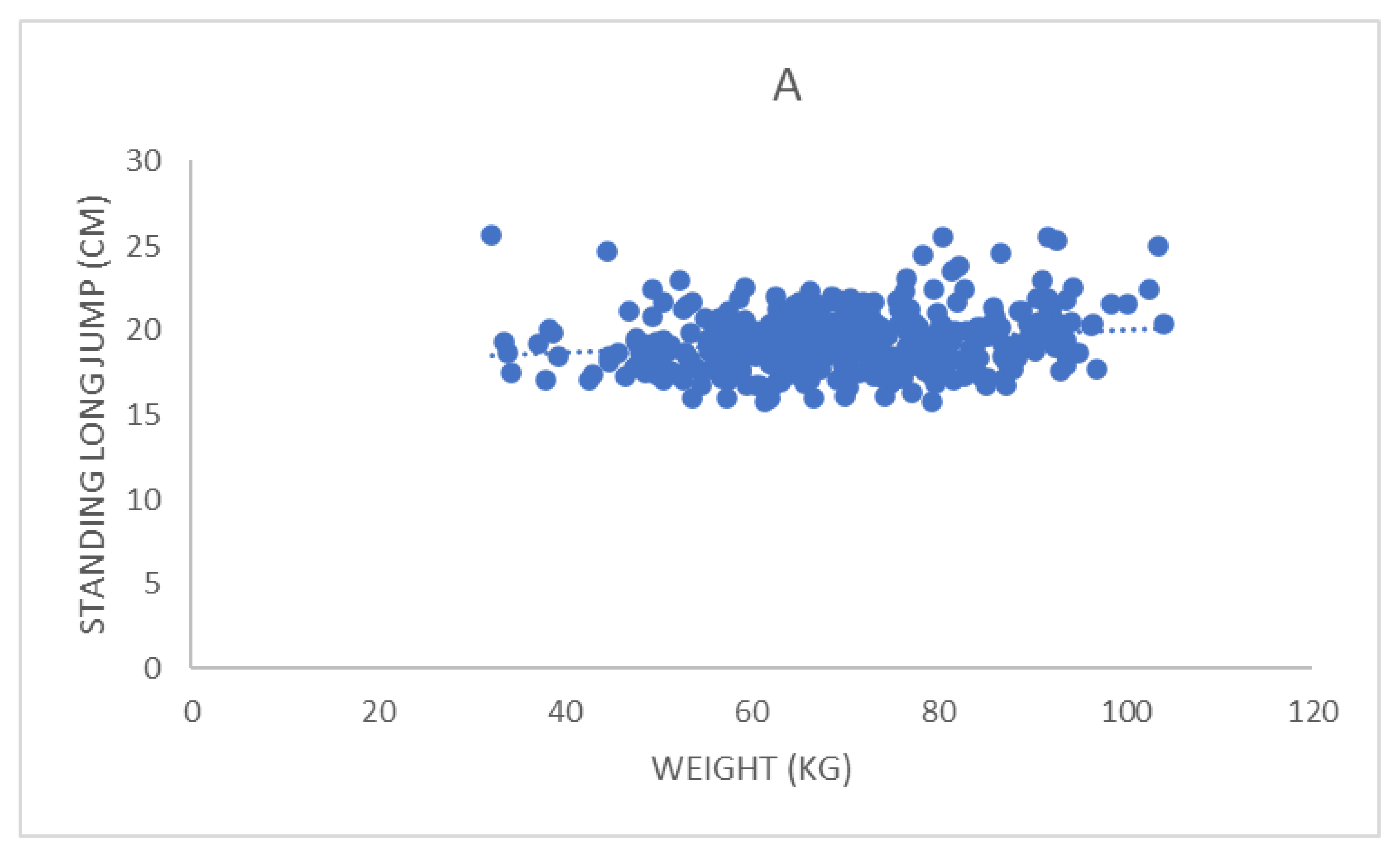
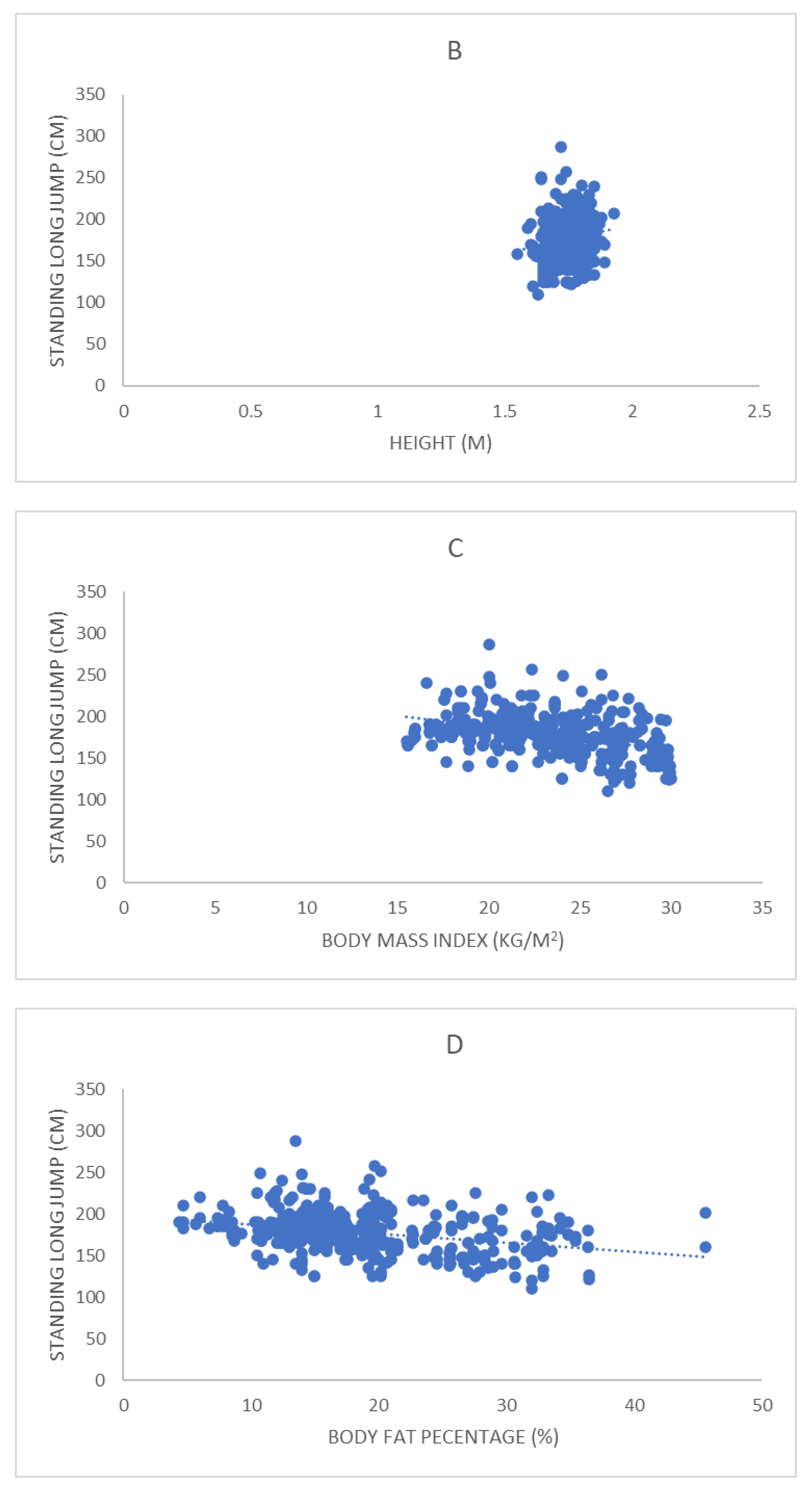
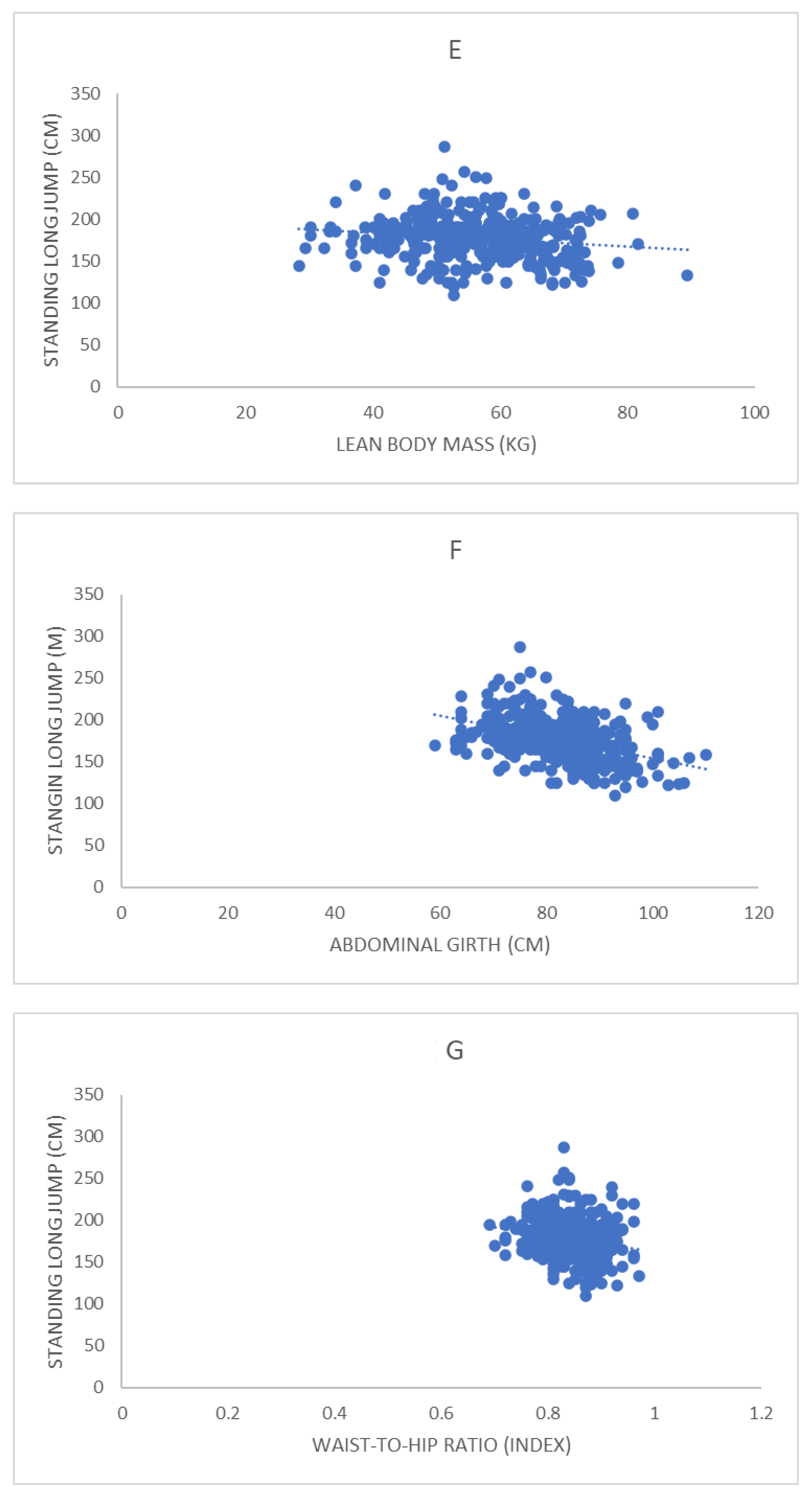
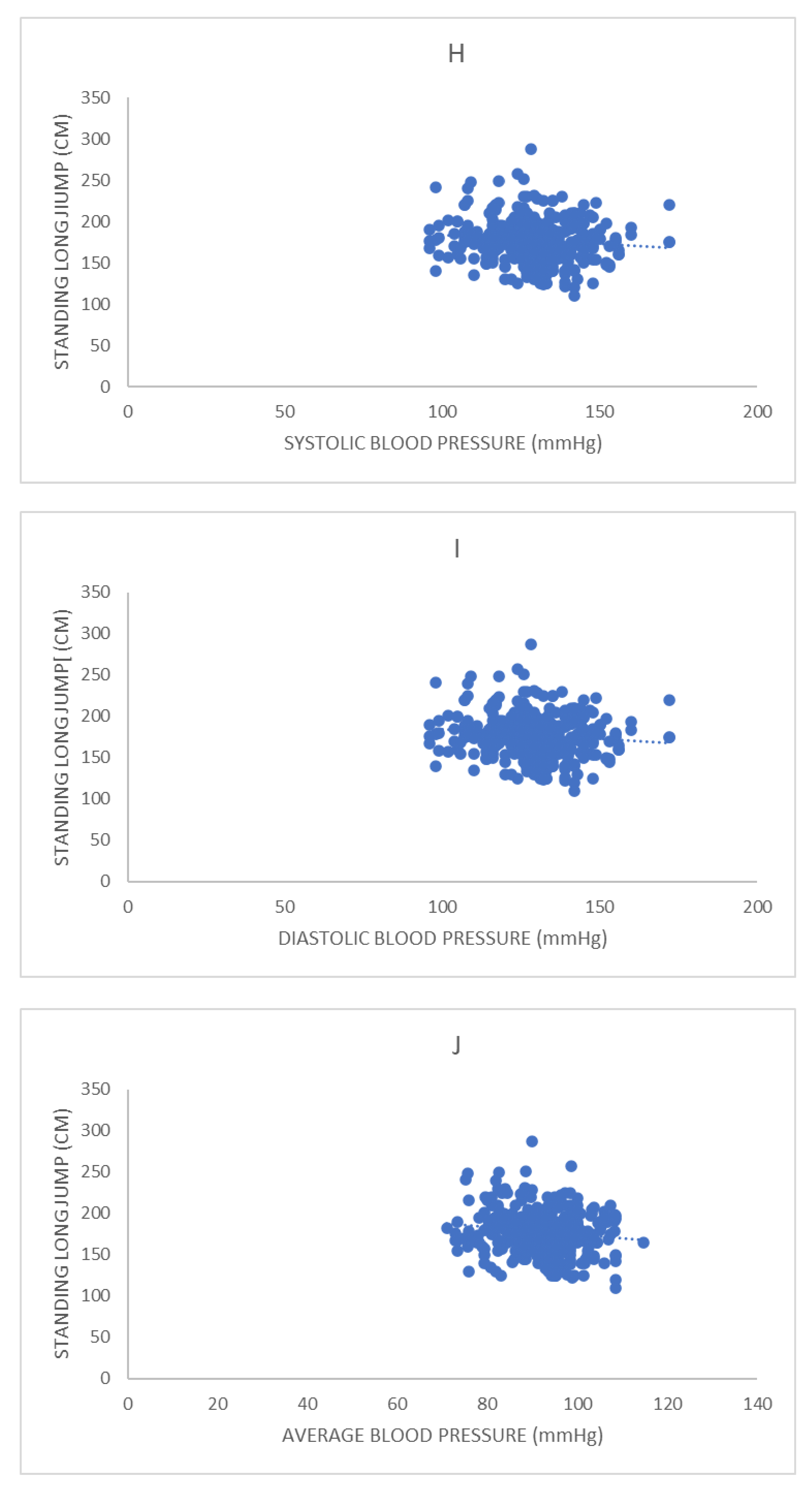

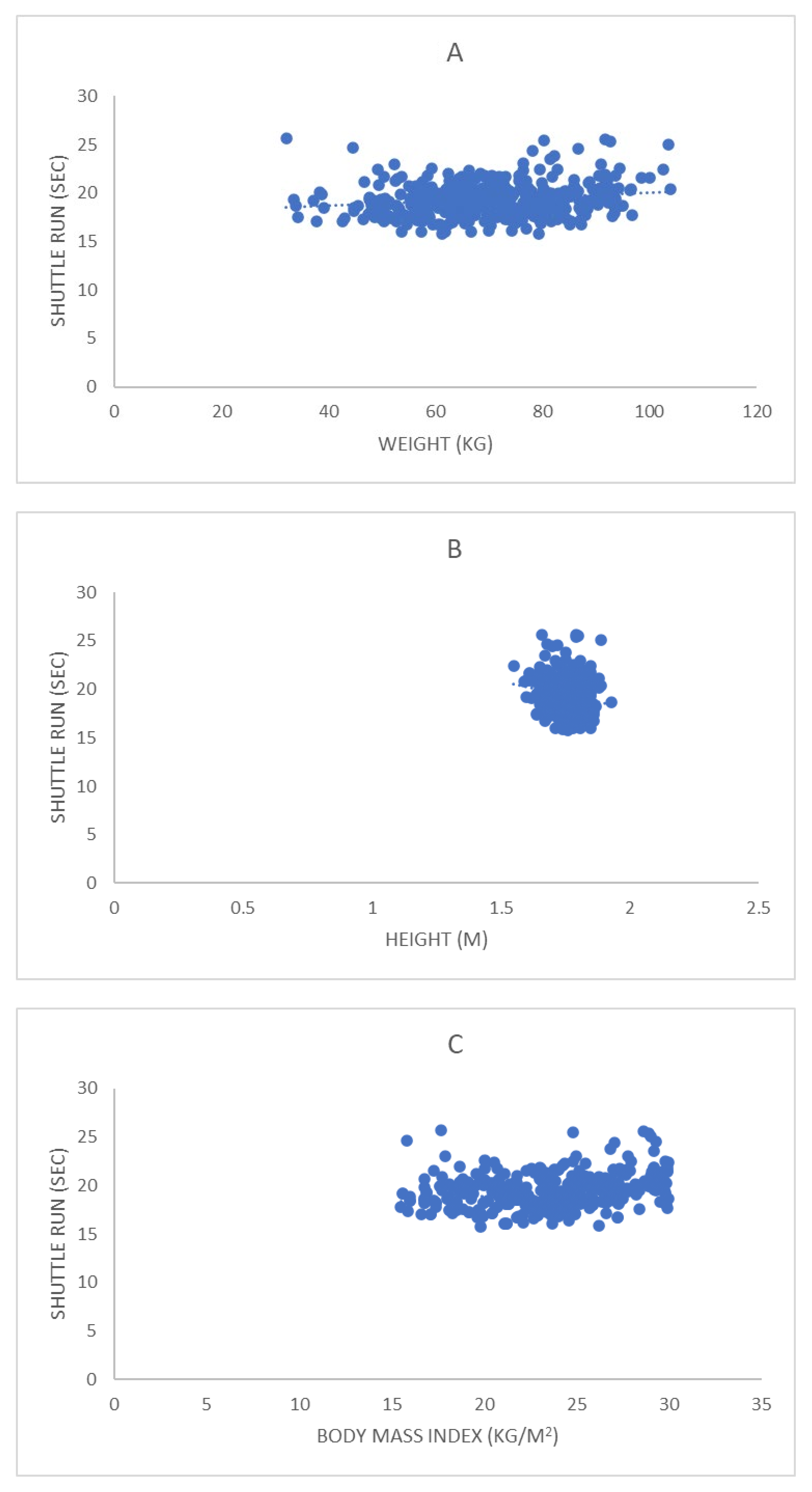
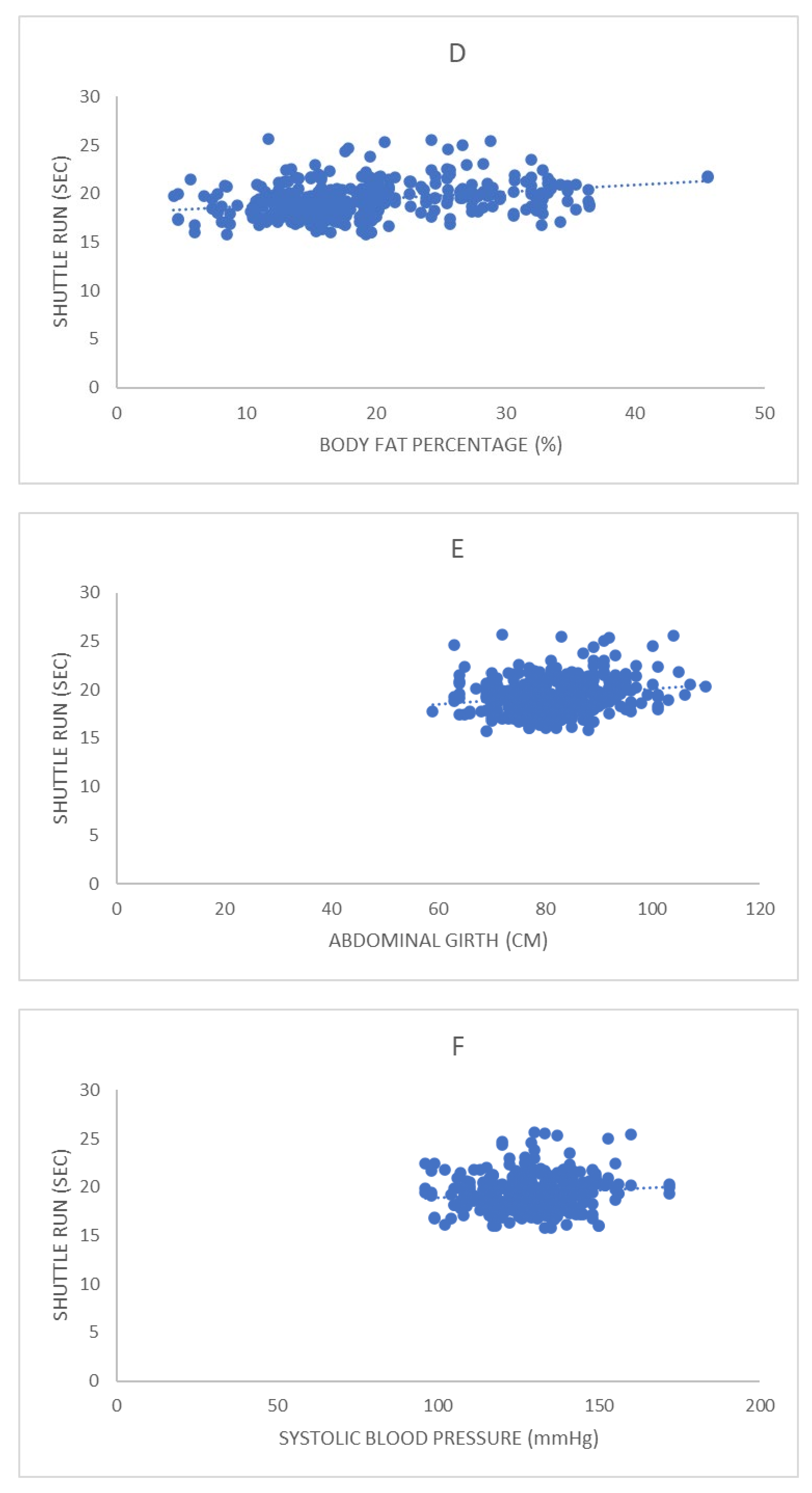
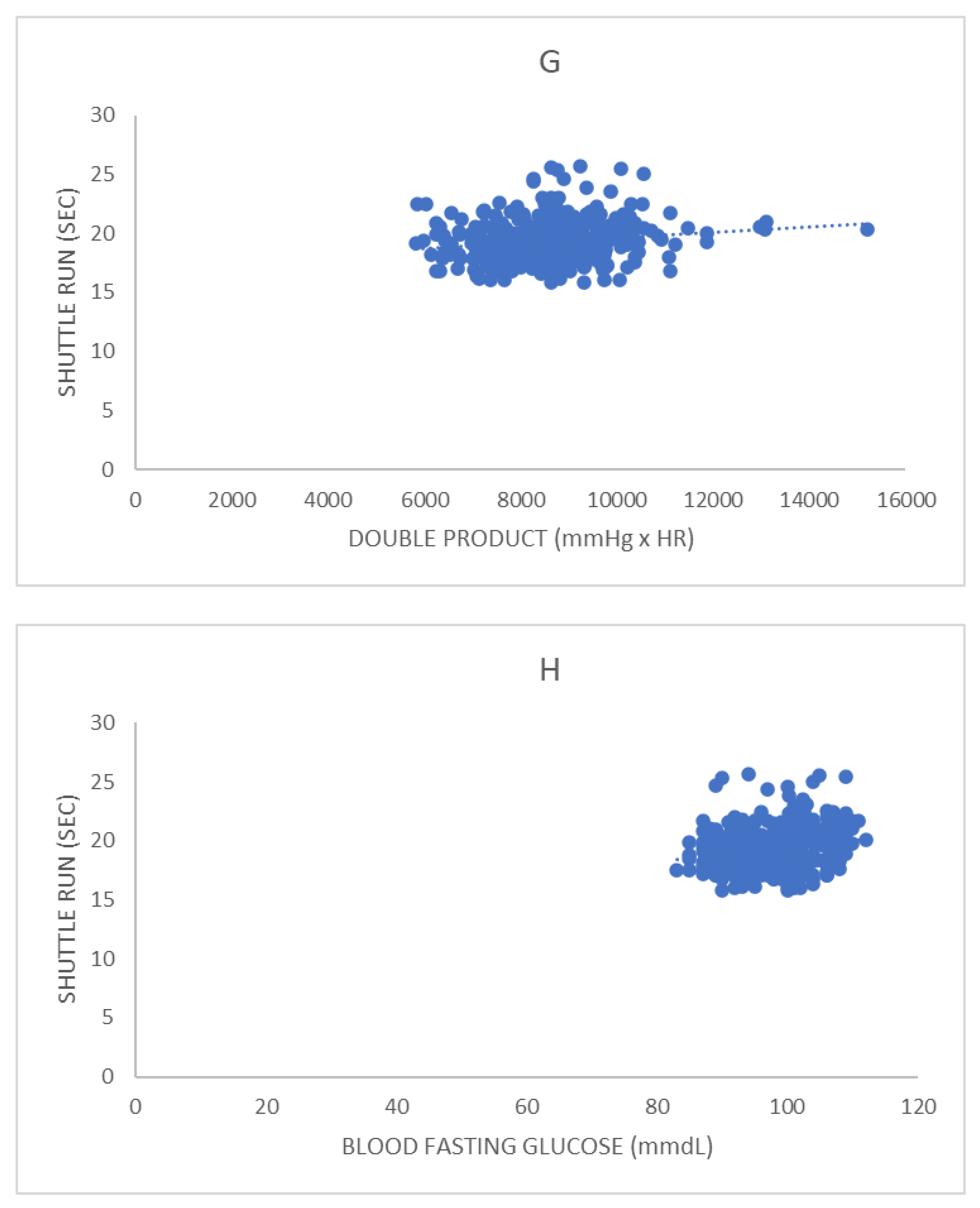
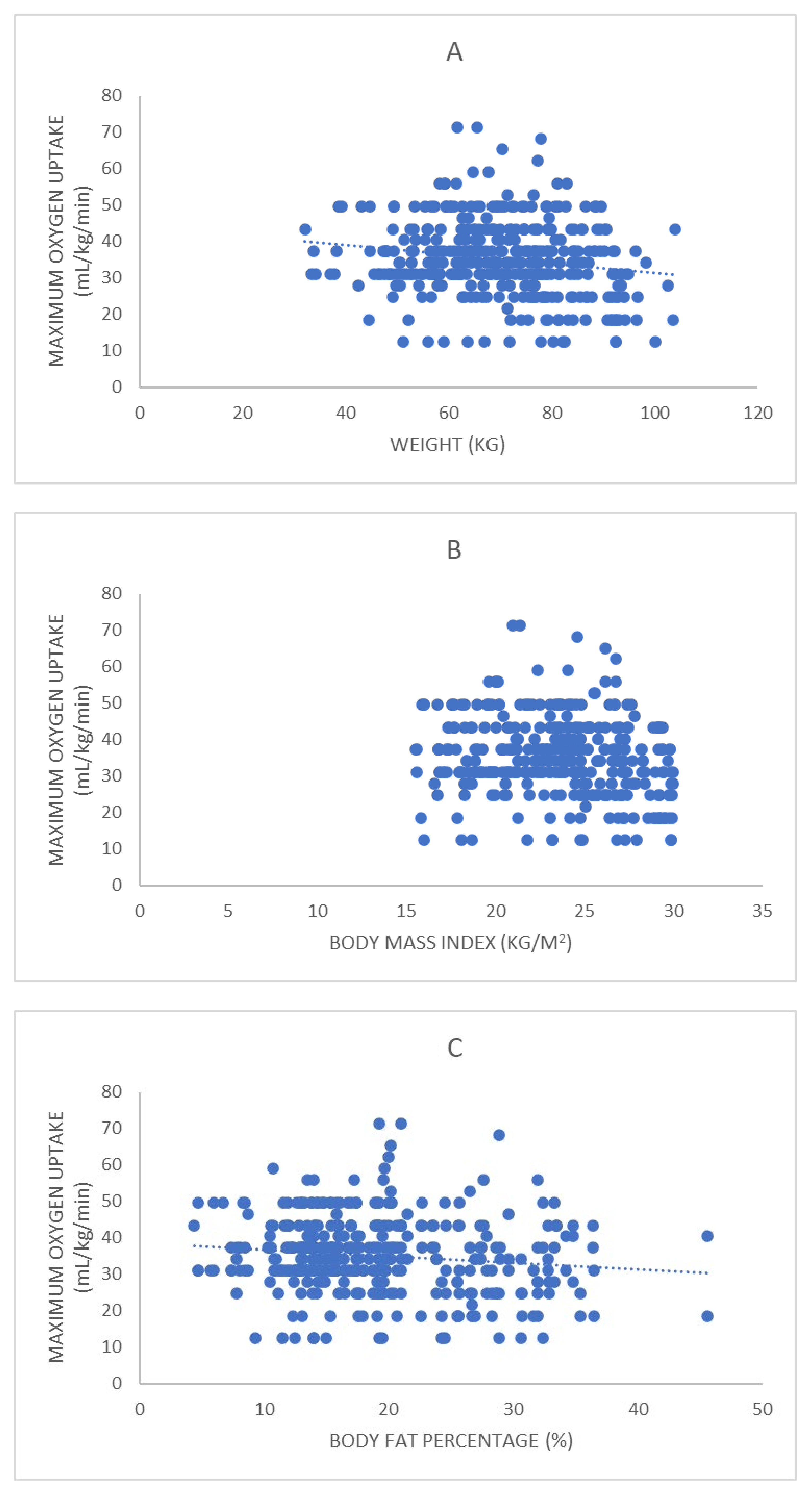
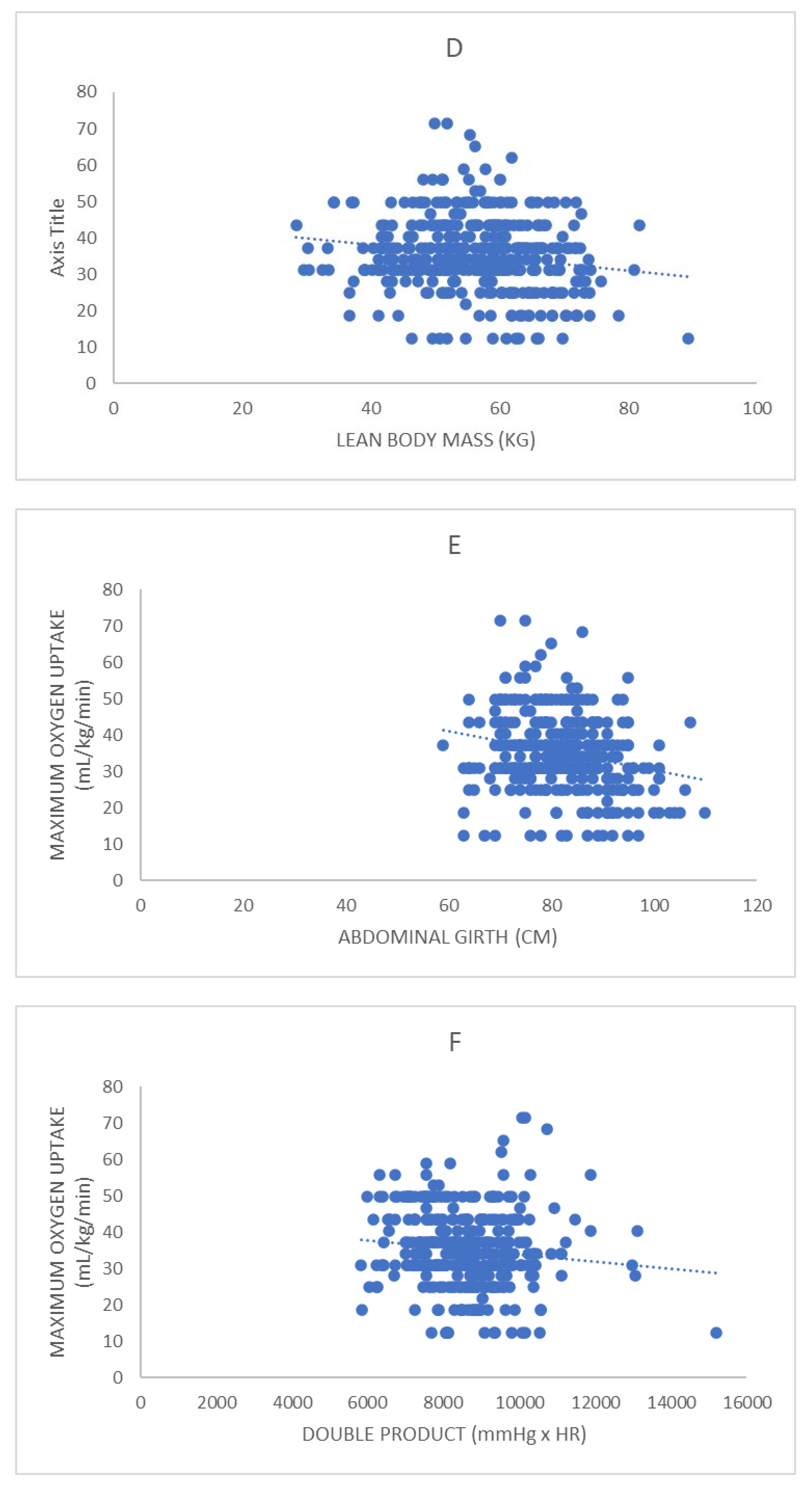
| Variable | Healthy or Acceptable Values | Unhealthy or Increased Risk Values |
|---|---|---|
| Body mass index (Kg/m2) | 18.5–24.9 | <18.5 or ≥25 |
| Body fat percentage (%) | ≤25.3 | >25.3 |
| Abdominal girth (cm) | <94 | ≥94 |
| Waist-to-hip Ratio | <90 | ≥90 |
| Systolic blood pressure (mmHg) | <140 | ≥140 |
| Diastolic blood pressure (mmHg) | <90 | ≥90 |
| Oxygen saturation (%) | 95–100 | ≤94 |
| Fasting blood glucose (mg/dL) | 70–100 | <70 or >100 |
| Variable | X̅ | SD | 95% Confidence Interval |
|---|---|---|---|
| Age (years) | 18.55 | 1.60 | 18.89–19.21 |
| Weight (kg) | 70.26 | 14.04 | 68.86–71.66 |
| Height (cm) | 175.93 | 4.06 | 1.74–1.77 |
| Body mass index (Kg/m2) | 23.45 | 3.69 | 23.08–23.81 |
| Body fat percentage (%) | 18.93 | 7.28 | 18.20–19.65 |
| Lean body mass (kg) | 56.40 | 9.85 | 55.42–57.39 |
| Abdominal girth (cm) | 81.79 | 8.72 | 80.92–82.67 |
| Waist-to-hip ratio (index) | 0.84 | 0.05 | 0.84–0.085 |
| Systolic blood pressure (mmHg) | 128.50 | 12.96 | 127.20–129.79 |
| Diastolic blood pressure (mmHg) | 73.68 | 8.54 | 72.83–74.54 |
| Oxygen saturation (%) | 97.43 | 5.25 | 96.90–97.95 |
| Average blood pressure (mmHg) | 91.95 | 7.89 | 91.17–92.74 |
| Double product (mmHg × HR) | 8595.53 | 1213.93 | 8474.67–8716.38 |
| Fasting blood glucose (mg/dL) | 98.40 | 5.66 | 97.84-98.97 |
| Sit-and-reach test (cm) | 0.75 | 9.12 | −0.15–1.66 |
| Standing long jump test (cm) | 177.5 | 25.18 | 175.07–180.08 |
| Shuttle run test (sec) | 19.35 | 1.73 | 19.18–19.53 |
| Maximum oxygen uptake (mL/kg/min) | 35.10 | 16.60 | 32.07–38.09 |
| WE | HE | BMI | FAT | LBM | AG | WHR | SBP | DBP | SPO2 | A-BP | DP | GLU | S&R | SLJ | SHR | VO2max | ||
|---|---|---|---|---|---|---|---|---|---|---|---|---|---|---|---|---|---|---|
| AGE | r | 0.06 | 0.07 | 0.05 | −0.08 | 0.14 * | 0.05 | 0.13 * | 0.04 | 0.17 * | −0.01 | 0.16 * | −0.03 | −0.04 | −0.007 | −0.01 | −0.09 | −0.03 |
| p | 0.23 | 0.12 | 0.33 | 0.09 | 0.006 | 0.29 | 0.006 | 0.40 | <0.001 | 0.77 | 0.003 | 0.52 | 0.39 | 0.88 | 0.79 | 0.052 | 0.79 | |
| WE | r | 0.35 * | 0.95 * | 0.49 * | 0.94 * | 0.75 * | 0.09 | 0.27 * | 0.21 * | −0.01 | 0.29 * | 0.34 * | 0.34 * | −0.06 | −0.24 * | 0.18 * | −0.17 * | |
| p | <0.001 | <0.001 | <0.001 | <0.001 | <0.001 | 0.80 | <0.001 | <0.001 | 0.99 | <0.001 | <0.001 | <0.001 | 0.21 | <0.001 | <0.001 | 0.001 | ||
| HE | r | 0.01 | −0.9 | 0.44 * | 0.13 * | 0.06 | 0.06 | 0.11 * | 0.11 * | 0.11 * | 0.05 | 0.06 | −0.02 | 0.17 * | −0.20 * | −0.05 | ||
| p | 0.77 | 0.06 | <0.001 | 0.1 | 0.21 | 0.26 | 0.27 | 0.03 | 0.03 | 0.34 | 0.25 | 0.69 | 0.001 | <0.001 | 0.22 | |||
| BMI | r | 0.62 * | 0.73 * | 0.83 * | 0.09 | 0.33 * | 0.22 * | −0.05 | 0.34 * | 0.41 * | 0.44 * | −0.05 | −0.41 * | 0.26 * | −0.17 * | |||
| p | <0.001 | <0.001 | <0.001 | 0.07 | <0.001 | <0.001 | 0.28 | <0.001 | <0.001 | <0.001 | 0.27 | <0.001 | <0.001 | <0.001 | ||||
| FAT | r | 0.26 * | 0.57 * | 0.07 | 0.16 * | 0.03 | 0.02 | 0.11 * | 0.27 * | 0.43 * | −0.01 | −0.31 * | 0.30 * | −0.13 * | ||||
| p | <0.001 | <0.001 | 0.13 | 0.001 | 0.56 | 0.71 | 0.03 | <0.001 | <0.001 | 0.77 | <0.001 | <0.001 | 0.01 | |||||
| LBM | r | 0.63 * | −0.14 * | 0.23 * | 0.23 * | 0.007 | 0.29 * | 0.28 * | 0.23 * | −0.06 | −0.16 * | 0.10 | −0.17 * | |||||
| p | <0.001 | <0.001 | <0.001 | <0.001 | 0.89 | <0.001 | <0.001 | <0.001 | 0.28 | 0.001 | 0.06 | 0.001 | ||||||
| AG | r | 0.37 * | 0.28 * | 0.21 * | −0.05 | 0.30 * | 0.35 * | 0.38 * | 0.13 * | −0.44 * | 0.20 * | −0.23 * | ||||||
| p | <0.001 | <0.001 | <0.001 | 0.31 | <0.001 | <0.001 | <0.001 | 0.014 | <0.001 | <0.001 | <0.001 | |||||||
| WHR | r | 0.13 * | 0.041 | −0.06 | 0.10 | 0.11 * | 0.08 | 0.001 | −0.20 * | −0.05 | −0.008 | |||||||
| p | 0.013 | 0.41 | 0.20 | 0.05 | 0.034 | 0.11 | 0.99 | <0.001 | 0.35 | 0.88 | ||||||||
| SBP | r | 0.23 * | −0.02 | 0.72 * | 0.79 * | 0.16 * | −0.06 | −0.11 * | 0.11 * | −0.05 | ||||||||
| p | <0.001 | 0.65 | <0.001 | <0.001 | 0.002 | 0.21 | 0.02 | 0.03 | 0.33 | |||||||||
| DBP | r | −0.04 | 0.85 * | 0.17 * | −0.08 | −0.08 | −0.12 * | 0.006 | −0.05 | |||||||||
| p | 0.43 | <0.001 | 0.001 | 0.14 | 0.13 | 0.023 | 0.89 | 0.28 | ||||||||||
| SPO2 | r | −0.04 | −0.01 | −0.05 | 0.008 | 0.08 | 0.002 | 0.05 | ||||||||||
| p | 0.42 | 0.79 | 0.30 | 0.87 | 0.14 | 0.96 | 0.33 | |||||||||||
| A-BP | r | 0.56 * | −0.03 | −0.09 | −0.15 * | 0.07 | 0.09 | |||||||||||
| p | <0.001 | 0.50 | 0.08 | 0.004 | 0.19 | 0.08 | ||||||||||||
| DP | r | 0.20 * | −0.03 | −0.16 * | 0.16 * | −0.20 * | ||||||||||||
| p | <0.001 | 0.50 | 0.001 | 0.002 | <0.001 | |||||||||||||
| GLU | r | 0.02 | −0.19 * | 0.19 * | −0.10 | |||||||||||||
| p | 0.73 | <0.001 | <0.001 | 0.06 | ||||||||||||||
| S&R | r | 0.24 * | −0.09 | 0.20 * | ||||||||||||||
| p | <0.001 | 0.07 | <0.001 | |||||||||||||||
| SLJ | r | −0.21 * | 0.30 * | |||||||||||||||
| p | <0.001 | <0.001 | ||||||||||||||||
| SHR | r | −0.19 * | ||||||||||||||||
| p | <0.001 | |||||||||||||||||
| Analysis | Dependent Variable | Included Independent Variable/s | R2 | p-Value | Standardized Coecient (β) | p-Value |
|---|---|---|---|---|---|---|
| Model 1 | S&R | AG | 0.015 | 0.014 | −0.12 | 0.009 |
| Model 2 | SLJ | AG HE | 0.24 | <0.001 | −0.47 0.23 | <0.001 <0.001 |
| Model 3 | SHR | FAT HE WE | 0.13 | <0.001 | 0.24 −0.19 0.17 | <0.001 0.001 0.005 |
| Model 4 | VO2max | AG | 0.05 | <0.001 | −0.23 | <0.001 |
| D.V. | P.V. | Nagelkerke R-Square | B | S.E. | Wald | df | Sig | Exp(B) | 95% CI for Exp(B) | |
|---|---|---|---|---|---|---|---|---|---|---|
| Lower | Upper | |||||||||
| BMI | S&R | 0.152 | 0.023 | 0.012 | 3.58 | 1 | 0.058 | 1.024 | 0.999 | 1.05 |
| SLJ | −0.016 | 0.005 | 11.62 | 1 | 0.001 * | 1.017 | 1.01 | 1.02 | ||
| SHR | −0.242 | 0.069 | 12.22 | 1 | 0.001 * | 0.785 | 0.686 | 0.899 | ||
| VO2max | 0.055 | 0.071 | 0.59 | 1 | 0.443 | 1.056 | 0.919 | 1.21 | ||
| FAT | S&R | 0.175 | −0.010 | 0.015 | 0.414 | 1 | 0.520 | 0.990 | 0.961 | 1.021 |
| SLJ | −0.237 | 0.006 | 17.03 | 1 | 0.001 * | 1.026 | 1.013 | 1.038 | ||
| SHR | 0.026 | 0.079 | 8.91 | 1 | 0.003 * | 0.789 | 0.675 | 0.922 | ||
| VO2max | 0.104 | 0.089 | 1.37 | 1 | 0.241 | 1.109 | 0.933 | 1.320 | ||
| AG | S&R | 0.227 | 0.017 | 0.023 | 0.595 | 1 | 0.441 | 1.018 | 0.973 | 1.064 |
| SLJ | 0.037 | 0.009 | 16.361 | 1 | 0.000 * | 1.038 | 1.019 | 1.057 | ||
| SHR | −0.044 | 0.107 | 0.171 | 1 | 0.679 | 0.957 | 0.776 | 1.179 | ||
| VO2max | 0.397 | 0.132 | 8.973 | 1 | 0.003 * | 1.487 | 1.147 | 1.927 | ||
| WHR | S&R | 0.034 | −0.012 | 0.014 | 0.637 | 1 | 0.425 | 0.989 | 0.961 | 1.017 |
| SLJ | 0.004 | 0.006 | 0.392 | 1 | 0.531 | 1.004 | 0.992 | 1.015 | ||
| SHR | 0.220 | 0.084 | 6.877 | 1 | 0.009 * | 1.246 | 1.057 | 1.469 | ||
| VO2max | 0.014 | 0.086 | 0.027 | 1 | 0.870 | 1.014 | 0.857 | 1.200 | ||
| SBP | S&R | 0.020 | 0.013 | 0.016 | 0.697 | 1 | 0.404 | 1.013 | 0.982 | 1.045 |
| SLJ | −0.001 | 0.006 | 0.035 | 1 | 0.851 | 0.999 | 0.988 | 1.010 | ||
| SHR | −0.155 | 0.078 | 3.945 | 1 | 0.047 * | 0.857 | 0.735 | 0.998 | ||
| VO2max | −0.027 | 0.086 | 0.096 | 1 | 0.757 | 0.974 | 0.822 | 1.153 | ||
| DBP | S&R | 0.023 | 0.017 | 0.023 | 0.595 | 1 | 0.441 | 1.018 | 0.973 | 1.064 |
| SLJ | 0.037 | 0.009 | 16.361 | 1 | 0.000 * | 1.038 | 1.019 | 1.057 | ||
| SHR | −0.044 | 0.107 | 0.171 | 1 | 0.679 | 0.957 | 0.776 | 1.179 | ||
| VO2max | 0.397 | 0.132 | 8.973 | 1 | 0.003 * | 1.487 | 1.147 | 1.927 | ||
| SPO2 | S&R | 0.001 | −0.006 | 0.026 | 0.049 | 1 | 0.825 | 0.994 | 0.944 | 1.047 |
| SLJ | 0.016 | 0.011 | 2.161 | 1 | 0.142 | 1.016 | 0.995 | 1.037 | ||
| SHR | 0.112 | 0.146 | 0.593 | 1 | 0.441 | 1.119 | 0.841 | 1.489 | ||
| VO2max | 0.094 | 0.158 | 0.351 | 1 | 0.554 | 1.098 | 0.806 | 1.497 | ||
| GLU | S&R | 0.117 | −0.009 | 0.012 | 0.576 | 1 | 0.448 | 0.991 | 0.968 | 1.015 |
| SLJ | 0.020 | 0.005 | 16.854 | 1 | 0.000 * | 1.020 | 1.010 | 1.030 | ||
| SHR | −0.202 | 0.066 | 9.260 | 1 | 0.002 * | 0.817 | 0.718 | 0.931 | ||
| VO2max | −0.007 | 0.069 | 0.009 | 1 | 0.923 | 0.993 | 0.868 | 1.137 | ||
Publisher’s Note: MDPI stays neutral with regard to jurisdictional claims in published maps and institutional affiliations. |
© 2022 by the author. Licensee MDPI, Basel, Switzerland. This article is an open access article distributed under the terms and conditions of the Creative Commons Attribution (CC BY) license (https://creativecommons.org/licenses/by/4.0/).
Share and Cite
Prieto-González, P. Relationship between Specific Field-Based Physical Fitness Test Results and Selected Health Biomarkers in College-Aged Males: A Cross-Sectional Study. Int. J. Environ. Res. Public Health 2022, 19, 14498. https://doi.org/10.3390/ijerph192114498
Prieto-González P. Relationship between Specific Field-Based Physical Fitness Test Results and Selected Health Biomarkers in College-Aged Males: A Cross-Sectional Study. International Journal of Environmental Research and Public Health. 2022; 19(21):14498. https://doi.org/10.3390/ijerph192114498
Chicago/Turabian StylePrieto-González, Pablo. 2022. "Relationship between Specific Field-Based Physical Fitness Test Results and Selected Health Biomarkers in College-Aged Males: A Cross-Sectional Study" International Journal of Environmental Research and Public Health 19, no. 21: 14498. https://doi.org/10.3390/ijerph192114498






